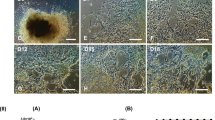Abstract
A method underlying a strategy for differentiation of the NT2 human teratocarcinoma cell line into neuronal and glial cells is described. The aim of this work is to provide a human model to study the relationships between neurons and glia in vitro during developmental or degenerative events. NT2 cells are seeded on polylysine precoated plastic or glass and differentiated by all-trans retinoic acid; persistent undifferentiated cells are eliminated by cytosine-β-D-arabinofuranoside; then cell cultures are maintained during four weeks until the appearance of glutamatergic receptors. Along the differentiation procedure, we have followed the expression of neuronal and glial phenotypes as well as the excitotoxic response to N-methyl-D-aspartate treatment taken as an indication of neuronal maturation. The procedure described leads to the development of a mixed population of neurons and glia sensitive to glutamate exposure.
Similar content being viewed by others
References
Andrews PW (1984). Retinoic acid induces neuronal differentiation of a cloned human embryonal carcinoma cell line in vitro. Dev Biol 103: 285–293. 0
Andrews PW, Damjanov I, Simon D, Banting GS, Carlin C, Dracopoli NC, Fogh J (1984). Pluripotent embryonal carcinoma clones derived from the human teratocarcinoma cell line Tera-2. Lab Invest 50(2): 147–162. 0
Andrews PW (1988). Human teratocarcinomas. Biochim Biophys Acta 948: 17–36. 0
Attwell D (1994). Glia and neurons in dialogue. Nature 369: 707–708. 0
Barres BA (1991). New roles for glia. J Neurosci 11: 3685–3694. 0
Cheung WMW, Chu AH, IP NY (1997). Identification of candidate genes induced by retinoic acid in embryonal carcinoma cells. J Neurochem 68(5): 1882–1888. 0
Fogh J, Trempe G (1975). Human tumor cells in vitro. In: Fogh J (ed), New human tumor cell lines, pp 115–159. New York: Plenum. 0
Hardy M, Younkin D, Tang C-M, Pleasure J, Shi QY, Williams M, Pleasure D (1994). Expression of non-NMDA glutamate receptor channel genes by clonal human neurons. J Neurochem 63(2): 482–489. 0
Jones-Villeneuve EM, Rudnicki MA, Harris JF, McBurney MW (1983). Retinoic acid-induced neural differentiation of embryonal carcinoma cells. Mol Cell Biol 3: 2271–2279.
Koh JY, Choi DW (1987). Quantitative determination of glutamate mediated cortical neuronal injury in cell culture by lactate dehydrogenase efflux assay. J Neurosci Meth 20: 83–90.
Kurie JM, Buch J, Eppinger TM, Moy D, Dmitrovsky E (1993). 9-cis and all-trans retinoic acid induce a similar phenotype in human teratocarcinoma cells. Differentiation 54: 123–129.
Kurie JM, Younes A, Miller WH, Burchert M, Chiu C-F, Kolesnich R, Dmitrovsky E (1993). Retinoic acid stimulates the protein kinase C pathway before of its H5E-nucleor receptor during human teratocarcinoma differentiation. Biochim Biophys Acta 1179: 203–207.
Kurie JM, Allopenna J, Dmitrovsky E (1994). Retinoic acid stimulates protein kinase A-associated G proteins during human teratocarcinoma differentiation. Biochim Biophys Acta 1222: 88–94.
Miller WH, Moy D, Li A, Grippo JF, Dmitrovsky E (1990) Retinoic acid induces down-regulation of several growth factors and proto-oncogenes in a human embryonal cancer cell line. Oncogene 5: 511–517.
Moasser MM, DeBlasio A, Dmitrovsky E (1994). Response and resistance to retinoic acid are mediated through the retinoic acid nuclear receptor γ in human teratocarcinomas. Oncogene 9: 833–840.
Munir M, Lu L, McGonigle P (1995). Excitotoxic cell death and delayed rescue in human neurons derived from NT2 cells. J Neurosci 15(12): 7847–7860.
Munir M, Lu L, Wang Y-H, Luo J, Wolfe BB, McGonigle P (1996). Pharmacological and immunological characterization on N-methyl-D-aspartate receptors in human NT2-N neurons. J Pharmacol Exp Ther 276(2): 819–828.
Parpura V, Basarky TA, Liu F, Jeftinija K, Jeftinija S, Haydon PG (1994). Glutamate-mediated astrocyteneuron signalling. Nature 369: 744–747.
Pfrieger FW, Barres BA (1996). New views on synapse-glia interactions. Curr Opin Neurobiol 6: 615–621.
Pleasure SJ, Page C, Lee VM-Y (1992). Pure, post-mitotic, polarized human neurons derived from Ntera 2 cells provide a system for expressing exogenous proteins in terminally differentiated neurons. J Neurosci 12(5): 1802–1815.
Pleasure SJ, Lee VM-Y (1993). Ntera 2 cells: A human cell line which displays characteristics expected of a human committed neuronal progenitor cell. J Neurosci Res 35: 585–602.
Rudnicki MA, McBurney MW (1987). Teratocarcinomas and embryonic stem cells. In: Robertson J (ed), Cell culture methods and induction of differentiation of embryonal carcinoma cell lines, pp 19–49. Oxford: IRL Press.
Staines WA, Morassutti DJ, Reul KR, Ally AI, McBurney MW (1994). Neurons derived from embryonal carcinoma cells have varied morphologies and neurotransmitters. Neurosciences 58: 735–751.
Stemple DL, Anderson DJ (1992). Isolation of a stem cell for neurons and glia from the mammalian neural crest. Cell 71: 973–985.
Temple S, Xueming Q (1996). Vertebrate neural progenitor cells: Subtypes and regulation. Curr Opin Neurobiol 6: 11–17.
Wolf BA, Wertkin AM, Jolly YC, Yasuda RP, Wolfe BB, Konrad RJ, Manning D, Ravi S, Williamson JR, Lee M-Y (1959). Muscarinic regulation of Alzheimer's disease amyloid precursor protein secretion and amyloid β-protein production in human neuronal NT2N cells. J Biol Chem 270(9): 4916–4922.
Wroblewski F, La Due JS (1955). Lactic dehydrogenase activity in blood. Proc Soc Exp Biol Med 90: 210–213.
Younkin DP, Tang C-M, Hardy M, Reddy UR, Shi QY, Pleasure SJ, Lee V-Y, Pleasure D (1995). Inducible expression of neuronal glutamate receptor channels in the NT2 human cell line. Proc Natl Acad Sci USA 90: 2174–2178.
Author information
Authors and Affiliations
Rights and permissions
About this article
Cite this article
Langlois, A., Duval, D. Differentiation of the human NT2 cells into neurons and glia. Methods Cell Sci 19, 213–219 (1997). https://doi.org/10.1023/A:1009731707443
Issue Date:
DOI: https://doi.org/10.1023/A:1009731707443




